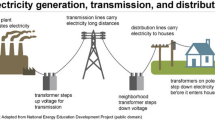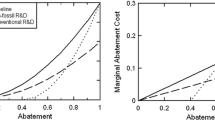Abstract
Entry of new firms into the electric power industry is becoming commonplace. The entrants typically are unregulated firms that compete with regulated electric utilities only in the generation stage of the latter's vertically integrated structure. Because of the asymmetric regulatory treatment of the incumbents and entrants, there is the possibility of biases either against efficient entry or for inefficient entry. A model of a vertical integrated utility subject to rate-of-return regulation is used to illustrate the biases, and several implications for regulatory policy are discussed.
Similar content being viewed by others
References
Atkinson, Scott, and Joe Kerkvliet 1989. “Dual Measures of Monopoly and Monopsony Power: An Application to Regulated Electric Utilities.” Review of Economics and Statistics 71 (May): 250–257.
Averch, H., and L.L. Johnson. 1962. “Behavior of the Firm under Regulatory Constraint.” American Economic Review 52: 1052–69.
Barclay, Paulette, Douglas Gegax, and John Tschirhart. 1989. “Industrial Cogeneration and Regulatory Policy.” Journal of Regulatory Economics 1 (September): 225–240.
Berg, Sanford V., and John Tschirhart. 1988. Natural Monopoly Regulation: Principles and Practice New York: Cambridge University Press.
Brennan, Timothy J. 1989. “Regulating by Capping Prices.” Journal of Regulatory Economics 1 (June): 133–148.
Burness, H.S., W.D. Montgomery, and J.P. Quirk. 1980. “Capital Contracting and the Regulated Firm.” American Economic Review 70: 342–354.
Cabral, Luis M.B., and Michael H. Riordan. 1989. “Incentives for Cost Reduction under Price Cap Regulation.” Journal of Regulatory Economics 1 (June): 93–102.
Crew, Michael A., and Paul R. Kleindorfer. 1979. Public Utility Economics New York: St. Martin's Press.
Federal Energy Regulatory Commission. 1987. Regulatory Independent Power Producers: A Policy Analysis. Washington, D.C.: Office of Economic Policy, (October).
Federal Energy Regulatory Commission. 1988. “Notice of Proposed Rulemaking, Administrative Determination of Full Avoided Cost, Sales of Power to QFs and Interconnecting Facilities.” RM 88-6-000 (March).
Henderson, J. Stephen. 1985. “Cost Estimation for Vertically Integrated Firms: The Case of Electricity.” Analyzing the Impact of Regulatory Change in Public Utilities edited by Michael A. Crew. Massachusetts: Lexington Books 75–94.
Idaho Public Utilities Commission. 1980. “Rulemaking Proceedings for the Consideration of Cogeneration and Small Power Production.” Case no. P-300-12.
Joskow, Paul L. 1974. “Inflation and Environmental Concern: Structural Change in the Process of Public Utility Price Regulation.” Journal of Law and Economics 17: 291–329.
Joskow, Paul L. 1989. Regulatory Failure, Regulatory Reform, and Structural Change in the Electric Power Industry. Brookings Papers on Economic Activity, Microeconomics edited by Martin N. Bailey and Clifford Winston. Brookings, Washington D.C. 125–208.
Joskow, P.L. and D.R. Jones. 1983. “The Simple Economics of Industrial Cogeneration.” The Energy Journal (January): 1–21.
MacAvoy, Paul W., Daniel F. Spulber, and Bruce E. Stangle. 1989. “Is competitive Entry Free? Bypass and Partial Deregulation in Natural Gas Markets.” Yale Journal in Regulation 6: 209–248.
Marino, Anthony M., and Joseph Sicilian. 1988. “The Incentive for Conservation Investment in Regulated Utilities.” Journal of Environmental Economics and Management (June): 173–188.
Meyer, Robert A. 1975. “Monopoly Pricing and Capacity Choice Under Uncertainty.” American Economic Review 65 (June): 326–337.
Panzar, John C. 1976. “A Neoclassical Approach to Peak Load Pricing.” Bell Journal of Economics 7: 521–30.
Panzar, John C. 1980. “Sustainability, Efficiency, and Vertical Integration.” Regulated Industries and Public Enterprise edited by P. Kleindorfer and B. Mitchell. Massachusetts: Lexington Books. 171–185.
Panzar, John C., and Robert D. Willig. 1977. “Free Entry and the Sustainability of Natural Monopoly.” Bell Journal of Economics 8: 1–22.
Rees, Ray. 1986. “Indivisibilities, Pricing and Investment: The Case of the Second Best.” Zeitschrift fuer Nationaloekonomie: 195–210.
Electric Utility Systems and Practices 1983. 4th ed., edited by Homer M. Rustebakke. New York: John Wiley & Sons.
Seligson, Carl H. 1989. “Driving Forces for Change in the Electric Power Industry.” Public Utilities Fortnightly 124 (October): 15–18.
Sherman, Roger. 1989. “Pricing Periods Under Rate-of-Return Regulation.” Journal of Regulatory Economics 1 (June): 163–174.
Spulber, Daniel F. 1989. Regulation and Markets Cambridge, MA: MTT Press.
Tschirhart, John. 1989. “Partial Regulation of Natural Monopoly.” in The Political Economy of Government Regulation edited by Jason F. Shogren, Boston: Kluwer Academic Publishers.
Wells, Charles W. 1989. “Prudence Audits are Narrowing Our Energy Choices.” Public Utilities Fortnightly 123 (May): 16–18.
Author information
Authors and Affiliations
Rights and permissions
About this article
Cite this article
Tschirhart, J. Entry into the electric power industry. J Regul Econ 3, 27–43 (1991). https://doi.org/10.1007/BF00157609
Issue Date:
DOI: https://doi.org/10.1007/BF00157609




